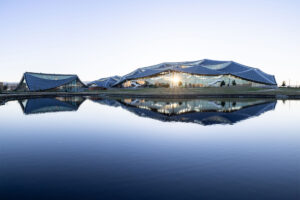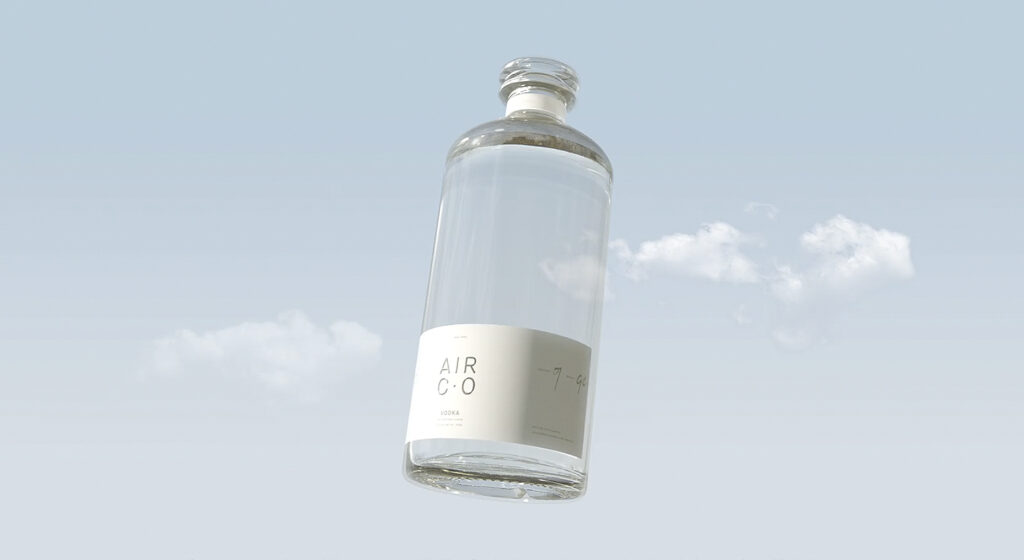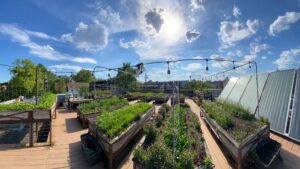
Michelle Kaufmann – Leading Sustainable Architect
Leading sustainable architect working on scalable innovations to deliver on Google’s 2030 Carbon aspirations and the hybrid future workplace.
USA
Seunghyun Natalia Woo August 16, 2021
Founded in 2017, Air Company is a technology and design start-up that strives to redefine how sustainability looks and feels in the consumer lifestyle industry, most notably by transforming CO2 into impurity-free alcohol. Based in Brooklyn, NY, Air Company was founded by Gregory Constantine and Dr. Stafford Sheehan. Both were previously recognized by Forbes “30 Under 30” in 2017 and 2016, respectively. Constantine was featured in the Marketing and Advertising category for his work leading global festival strategy and cultural partnerships at Smirnoff, Diageo. Sheehan was featured in the Energy category for his research on heterogenized homogeneous catalysts used in industrial materials.
Together, the co-founders work to tackle difficult and pressing issues, particularly around climate change and space exploration, with partners such as NASA. Their proprietary technology uses renewable solar energy to convert carbon dioxide into different byproducts of alcohol that can then be used to create consumer lifestyle products or fuels for future space missions.
In 2020, Air Company launched Air Vodka, a carbon negative, 80-proof premium spirit that removes a pound of carbon dioxide from the air with every bottle produced. Most recently, Air Company released Air Spray, a hand sanitizer made from carbon dioxide that both kills germs and cleans up the air. In response to the COVID-19 pandemic, Air Company has donated over 15,000 bottles to environmentally-focused non-profit organizations as well as other organizations providing critical services in New York City. Air Company will continue to extend its revolutionary line of products with a new fragrance, expected to be released later this year.
Mood of Living: Briefly introduce yourselves: what are your respective roles as Co-Founders of Air Company?
Gregory Constantine: I’m the Chief Executive Officer (CEO) of the company. My role is running the business and putting a lot of the strategies in place to become successful in the short and long term. We’ve got a big focus on using technology to do good in the world. So, a big focus of mine is allowing Air Company to see the light of day through its products and innovation.
Dr. Stafford Sheehan: I’m the Chief Technology Officer (CTO). My role is managing our technology development — making sure that we’re developing our technology and products in a way that resonates well with our customers. I’m also responsible for developing the strategy to scale our technology while mitigating risk, ensuring that we have products as we scale.
MoL: Where are you currently living, and where did you grow up? What are your respective academic backgrounds? How did you two meet?
GC: I’m currently based in New York City. I’ve been in New York for almost 10 years. But I grew up in Sydney, Australia and received my undergraduate degree there. Then, I moved to the United States, where I ended up getting recruited by a big alcohol company. I received my MBA at Harvard, and then I met Staff [Dr. Stafford Sheehan] overseas.
SS: I’m also based in Brooklyn, NY, but I was born and raised in Rhode Island, about four hours up I-95 (a bit closer than where Greg grew up). Greg and I actually met up overseas during a trip to Israel, although we were both based in the United States at the time. I studied chemistry, physics and math during my undergrad at Boston College and then went to Yale University for my PhD. I did my PhD in physical chemistry, which bridges between applied physics and chemistry. I was in a group called the Yale Solar Group. At Air Company, the sort of science and chemistry we do strives to do the same thing — bridge together physics, chemistry and engineering. The field is called artificial photosynthesis, where you try to mimic what trees and plants do. By that, I mean breathing in carbon dioxide and taking in water to store that carbon dioxide as a hydrocarbon, with the only emission being oxygen — which we know is perfectly fine to have in the atmosphere.

MoL: What brought you both together to build a business?
GC: For us, the reason why we create products is to demonstrate that sustainability doesn’t have to be boring. Essentially, by operating in existing categories where our technology can be applied, we want to be able to provide solutions that are better for you and better for the planet. We do that through our own products. But utilizing our technology for the long run is where we can create real change at a larger scale. That’s why we spend a lot of time developing ideas and innovating. This is what allows us to get up every day and work on the things we’re doing. It’s hard, but it’s purposeful — that’s why we love doing it.
SS: Both of us have a strong statement about sustainability, which really drove us to start Air Company. That’s something that we both realized early on, and why the goals of the company are heavily focused on sustainability and environmental stewardship. The company really reflects both Greg and me, as co-founders, in that we want to find a way to take what we’re doing and use it in a way that has a global impact in solving climate change. At the time, I was working on carbon dioxide conversion technologies, and Greg was in the alcohol industry as a business executive. When you convert carbon dioxide into small, short-chain alcohols, like ethyl alcohol (the one you drink), there are a lot of value propositions. We saw that synergy along with our alignment in environmental and sustainability goals; this is what really drove us to start Air Company.
MoL: What is Air Company’s mission? Have the mission and goals evolved?
GC: The end goal is always the same: to preserve and extend humanity. But this end goal also trickles down by helping to reduce climate change in the interim. That’s the reason why we were able to work on projects, like cleaning the air on Earth, while working with partners (like NASA) to extend our technology into outer space. So, how we get to our end goal may shift, slightly, but we’re solely focused on this task.
MoL: How does your patented technology transforming CO2 from the air work?
SS: I learned broadly about the field during my PhD studies. It’s like I learned about engines but didn’t specialize in engines; then, we made a new engine at Air Company. But water is where the process all starts. The technology works by first splitting water into hydrogen and oxygen. While the oxygen gas is released as an emission, you take the hydrogen and combine it with carbon dioxide at the right temperature, pressure and catalyst to turn it into alcohol. With this mixture of alcohols from water, you distill that to get the pure alcohol.
MoL: What was the research process and timeline in developing this technology?
SS: In 2017, we were about one-twenty-thousandth the size that we are now. Until 2018, our systems were operating at a laboratory benchmark scale. But in 2019, our large prototype (our plant in Brooklyn, NY) went live, and that’s when we started making products. Over the course of 2020, we deployed our pilot power plant in Calgary, Canada that works to capture carbon dioxide from natural gas. That system has recently been operating 24/7. So, it’s taken a little over four years to scale up 20,000 times since we were in the laboratory. The challenge for us and any CO2 utilization company is the scaling challenge. In fact, there’s a lot of laboratory work where we’re standing on the shoulders of giants. During the ’60s, ’70s and ’80s, a lot of the carbon dioxide conversion techniques (and pretty much anything) had already been done in the laboratory. But these technical works fell off the radar because no one was able to scale those technologies.
MoL: Tell us about your journey–from conceptualizing to launching your start-up. How have you expanded since the beginning of the company?
GC: In the last three years, we’ve grown from just two people, me and Staff, to currently 27 people. There’s been a pretty significant ramp up from the last course of years that’s due to the work we’re putting in and challenges we’re trying to tackle. It’s no easy feat. Having gone from the smallest scale of prototype, to producing a product, to that product being in every New York City Michelin star restaurant, and to finally going on to win Time Magazine’s “Best Inventions of 2020,” shows a real trajectory from the product and production side. As Staff mentioned, we were one-twenty-thousandth smaller than what we currently are, and beyond that, we now operate three facilities and an office. We have a catalyst laboratory in Princeton, a testing facility in Brooklyn, and a production facility currently in Canada that’s going to be moving to Brooklyn before the end of the year. So, the progression has been quite drastic when you add up the amount of work that’s been done. We couldn’t have done it without the team and our partners, like NASA and across the board. It’s been a long road, but we’re in a space that we love working in. And hopefully, we’re looking to grow even more drastically over the next few years.
MoL: As Air Vodka is only the beginning for Air Company, do you plan on expanding your product line? Are there other projects or consumer products that Air Company is working on?
GC: Products are the easiest way for us to show the world that you can use and create products that are both better for the people and planet. While we started with Air Vodka and Air Spray (our hand sanitizer that was recently created in a time of need), we’ll continue to develop more products because it’ll allow us to further scale our technology and background. We’re also going to come out with a fragrance later this year. We really hope that this will allow people to see us beyond a spirit company. We want the opportunity to showcase that we can create these really beautiful products that are sustainable and better for the planet, all while looking and feeling just as great as their predecessors. And so, products are a great way for us to tell stories while using the climate as a backbone.
Dr. Stafford Sheehan
MoL: Tell us more about Air Stellar, your venture for outer space: What is the mission of Air Stellar?
GC: It’s really centered around that one big goal: how do we preserve or extend humanity and how do we solve really challenging problems? When we first set out, climate change was obviously the most existential problem facing Earth, so we wanted to go and help solve that. Along the way, we spent time understanding that our technology was also potentially applicable beyond Earth. For us, while contemplating through these tough scientific and technological problems — especially, deciding whether to focus more on space exploration or existential extension — we decided to internally put the small amount of time, effort, energy and resource to tackle both. And so, Staff and his team have gone on to develop the technologies to be able to do so.
SS: One of the aims of Air Stellar and the work that we’ve been doing in space is to help advance carbon dioxide conversion on Earth. You can think of it like solar cells. Today, solar panels are all over the place; they’re pretty ubiquitous and one of the best tools we have to fight climate change. They even power our distilleries in New York City. But in 1970, there were no solar cells to be seen anywhere except for in outer space to power space stations. Yet, this was one of the big proof points for solar cells to show their effectiveness. One of the ways we see carbon dioxide conversion technology becoming better deployed on Earth is similar to this strategy. Right now, carbon dioxide conversion technology is really needed in outer space for things like life support and habitability on Mars. Like solar cells, carbon dioxide conversion technology needs to get to outer space before they can get to our own rooftops. But fortunately, with carbon dioxide conversion, there are a lot of different avenues for us to take. That’s why we have consumer goods here on Earth, and we’re also working on projects for refueling, glucose production and other things like that for outer space.
Air Stellar Render
MoL: What are some of the space exploration projects that Air Stellar has been in working on with NASA?
SS: There are two things that we’ve been working on with NASA. First is the production of glucose from carbon dioxide without having any biological organisms as intermediaries. The context behind this is, if you’re on a space mission, you want a product that can be feed stock for microbes, plants or other things that can be used for food or advanced chemistry in outer space. You want something that can’t die. You don’t want to show up to a space station with all your microbes dead and then suddenly have no food source. The way NASA proposed to solve this problem was to produce glucose in completely abiotic systems, with nothing in there that could die. It’s all hard-core chemistry. So, this was the concept we were worked on, and we demonstrated that we could successfully convert carbon dioxide into sugars without the aid of any living organisms. For this work, we became the winner of the NASA CO2 Conversion Challenge, and we were featured by them a couple of times. We’re still continuing on with this project; it’s still a work in progress. But following the competition, we were invited to a consortium of space flight scientists from NASA, Cornell, European space agencies and other groups. There, we presented our second project: our concept for carbon dioxide conversion into cryogenic liquid methane. We demonstrated that this fuel converted from our carbon dioxide conversion reactors would be compatible with space flight. So, this is something we’re also working on in the background.
MoL: How did you transition from producing spirits to developing space technology?
SS: There wasn’t really a transition; it’s all part of the carbon dioxide conversion. All the things we’re working on for space use alcohol as an intermediary. So, it really is just taking the technology that we’ve already been using to make Air Vodka and sanitizers and finding applications for that technology to further benefit humanity.
MoL: We see that Air Studio also works to merge design and creativity with technology. Who were some of the partners you have previously collaborated with?
GC: Air Studio is a platform that allows us to spend time working with creatives. The reason why we spend so much time on design is because we believe that design is integral to merging deep science and technology into society; you need technology to be accessible to people. We want people to understand and buy into sustainable technology. What we focus on at Air Studio is working with creatives that have that same sensibility. Last year, we worked with an emerging industrial designer, Benjamin Edgar, who focuses on reusability, especially with products that can be reused repeatedly. When you’re creating products, you’re trying to be as sustainable as possible. And, for something to be reused is one of the utmost heights of sustainability. Overall, all the collaborators that we work with are centered around using or understanding technology to merge it with creativity because that’s at the core of what we do. We look at companies like Apple. Back in the day, Steve Jobs was the biggest proponent of technology and creativity and bringing those two together to make incredible things happen. We like to foster these values internally and then hopefully foster the same externally as well.
MoL: What did those creative projects at Air Studio look like?
GC: We spend a lot of time working on things, as does Staff and the technical team, but it’s not often that the product or end result sees the light of day. I think one big focus for our company, and with our collaborators in the physical and digital space, is making sure that whatever we put out is the absolute best it can be. With Ben, we created a one-of-kind piece, reusable bottle cap that acted as a cap for the bottle and doubles as a keychain or paperweight at home. So, when you talk about taking our Air Vodka bottle and potentially reusing it beyond its initial purpose (whether as a water bottle or vase), the bottle cap acting as a keychain really builds upon this sensibility of taking design to repurpose products later in their life.
MoL: We see that Air Ventures works to support other entrepreneurs and innovative technologies who share your goals of inspiring a cleaner future. What organizations do you support? How else have you supported your local communities?
GC: Since starting Air Company, one thing we have seen a lot over the last eight to twelve months is new innovative technologies and companies coming to us for advice. We’ve become a proven point for other people to go do great things by taking really hard science and bringing it into the world. What you’ll see over the next 12 months is some real development in this space, and hopefully, we can use our experience and learnings to really help others. We started Air Ventures about a year ago, and we are always actively looking for companies both locally, in and around the New York area, and beyond. We hope to help by utilizing both our team, network and knowledge. Like I said before, what we’re doing is hard stuff — you, more often than not, are going to fail. And we fail daily at a lot of things, but it’s about taking the values and learning from them to build on.
MoL: What types of companies are you usually approached by?
GC: We sit on the advisory boards of few companies and government bodies and get approached across the board. But from our point of view, we love to try to focus on companies with similar sensibilities as us: those who tackle really challenging problems that other people may or may not try to do. We love when they’re centered around the environment, of course, or when they’re centered around doing good in the world. But those who are tackling problems, and honestly the harder the better, are what we like. It’s kind of the path with the most resistance, and it’s the path that we chose as well. But it’s one that’s really rewarding in the end.
MoL: What advice can you give to budding entrepreneurs who are interested in starting their own tech start-ups?
GC: From an advice point of view — go out and don’t be afraid to fail. Try to do things that are tough.
SS: Both Greg and I have advised a lot of budding entrepreneurs and businesses in this space. So, I would say that it really depends on the person, but overall, I would also say to go out and tackle the big problems. Try to tackle the problems that will have a global impact.
MoL: What are you most excited about for the future of Air Company?
GC: We’re most excited about the impact that we can have on this planet for years and years to come. I’m really excited about how we can help pave way for other companies and hopefully for entrepreneurs as well. Because when you see a company like ours, which we hope to become successful in the future, it’ll show people that doing really tough things is possible. Product wise, we’re super excited about putting out a new fragrance this year. It’s going to be the most amazing — I’m really excited about it! To go out and put a product in the spirits category is one thing, but to hopefully be polarizing in another category is tremendous for us.
SS: We’re most excited to be scaling our technology to even more significant levels, where we can have a greater substantial impact on the environment. I mean, that’s the biggest focus of the business and what we’re most excited about.
Photography courtesy of Air Company
Banner Image: Gregory Constantine, Dr. Stafford Sheehan

Leading sustainable architect working on scalable innovations to deliver on Google’s 2030 Carbon aspirations and the hybrid future workplace.

Founded by Helen and Mike Cameron, Uncommon Ground is America’s first certified organic rooftop farm.

Located outside of Paso Robles, California, Villa Creek Winery prioritizes the cultivation of organic and biodynamic wine.